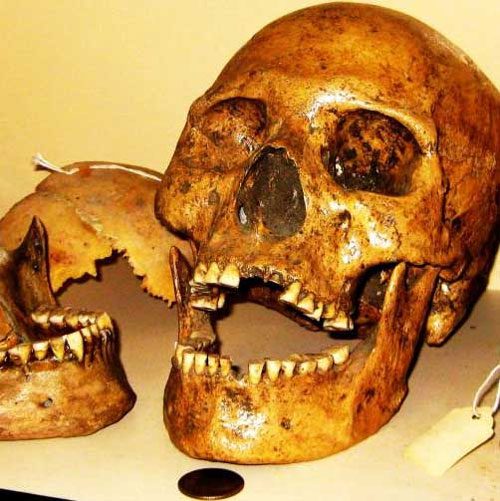The indigenous Paiute tribe in Nevada (USA) has a legend about their ancestors and the red-haired giants known as Si-Te-Cah. Although they were just a small group, the Si-Te-Cah constantly attacked and kidnapped members of the Paiute tribe to eat them.
According to the legend, the Paiute fought back against the giants and pursued them to their lair. Determined to eradicate the Si-Te-Cah, the Paiute stacked wood at the entrance of Lovelock Cave and set it ablaze. Some giants who escaped from the cave were struck down by arrows, while the others inside perished from smoke and flames. Ultimately, an earthquake buried Lovelock Cave, erasing all traces of the red-haired giants.
Lovelock Cave in Nevada (USA) was first explored in 1913. By 1924, an archaeological expedition from the University of Berkeley began investigating and uncovering its secrets. Lovelock Cave, which is about 12 meters deep and 18 meters wide, was initially called Horseshoe Cave due to its U-shaped interior.

The skull of a giant next to the skull of a regular human at the Humboldt Museum.
Many Native American tribes still pass down legends of the red-haired giants and how their ancestors fought in terrible battles against these cannibals.
Even the Aztecs (who primarily lived in Central and Southern Mexico during the 14th and 15th centuries) and the Maya (a civilization that thrived from the 4th to the 8th century in Central America and Southern Mexico) also encountered the northern giant race. Furthermore, giant remains have been found across continents.
In 1931, two enormous skeletal remains were discovered at the bottom of Humboldt Lake near Lovelock. One skeleton was 2.5 meters tall and was described as being wrapped in a cloth cover made of resin, unlike Egyptian mummies. The other skeleton was 3 meters tall.
In 1950, the fossil of a giant with a femur measuring 1.2 meters long was found near the Euphrates River in Turkey, and scientists estimated that this individual was about 5 meters tall. In 1970, the skeleton of a red-haired giant was uncovered in the Amazon region.
In 1976, archaeologists from the Smithsonian Institution (USA) discovered additional remains of a man approximately 2.5 to 3 meters tall in the Kurdish region of Southern Turkey.

A decoy duck found in Lovelock Cave displayed at the Smithsonian Museum.
In 2004, the remains of a giant approximately 3 meters tall were discovered after a tsunami hit Phi Phi Island in Thailand. In 2005, two ancient graves of giants over 10 meters long were uncovered in Syria.
The Paiute people referred to the red-haired giants as Si-Te-Cah, meaning “the people who eat bulrush”, for two reasons: bulrush is a plant that grows in marshes and was used by the giants to build rafts for escape; secondly, these giants often kidnapped women who harvested bulrushes around Humboldt Lake.
Archaeologists found over 10,000 artifacts and the mummies of two red-haired giants inside Lovelock Cave – one female approximately 1.9 meters tall and one male over 2.4 meters tall. Subsequently, many artifacts from Lovelock Cave were transferred to the Nevada Historical Society in Reno, though some also ended up in the hands of private collectors.

The trail leading to Lovelock Cave.
In 2005, anthropologist Adrienne Mayor (USA) published a book titled Fossil Legends of the First Americans. She suggested that the gigantic size of the Si-Te-Cah may have been a misunderstanding.
The area of Nevada is rife with fossils of mammoths, cave bears, and other large animals. The initial excavators, lacking professional training, may have misidentified these as human bones, while the red hair could have been influenced by various factors such as soil, water, temperature, etc., after being buried for such a long time.
In 2013, two Bigfoot hunters, MK Davis and Don Monroe, unexpectedly published a collection of photographs of the Lovelock giants. These photos documented handprints on cave rock that were twice the size of an average human hand, potentially belonging to the Si-Te-Cah.
Along the borders of Peru and Bolivia (two countries in South America), several skulls have been found near Lake Titicaca, claimed to be the skulls of giants due to their red hair and elongated shape.
Among the indigenous tribes around Lake Titicaca, there are also oral traditions about red-haired giants adept at constructing and navigating reed boats, similar to the legends of the Si-Te-Cah among the Paiutes. The only difference is that this giant race is referred to as the Uros people.
Today, Lovelock Cave is an important site recognized by the U.S. Government and was added to the National Register of Historic Places in 1984. Visitors to the Humboldt Museum of Natural History in Winnemucca, Nevada (USA), can see several artifacts, skulls, and jawbones of giants.
In Winnemucca, Nevada, there is a small museum displaying artifacts found in Lovelock Cave, although none of these artifacts serve as evidence for the existence of the red-haired Si-Te-Cah giants.
Additionally, other major museums across the United States also exhibit remnants of red-haired giants – for instance, a decoy duck found in Lovelock Cave is displayed at the Smithsonian Institution, while bone fragments are in the Nevada State Museum.


















































